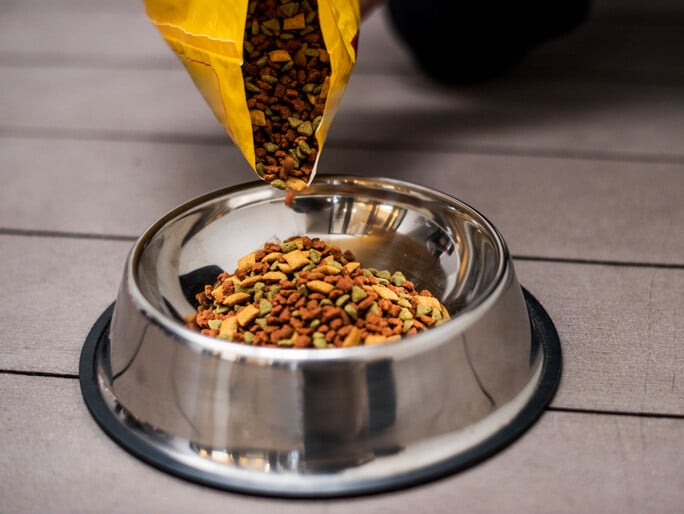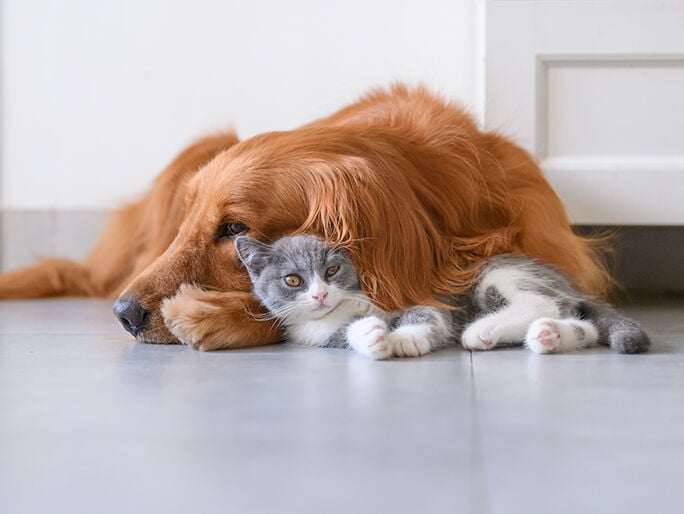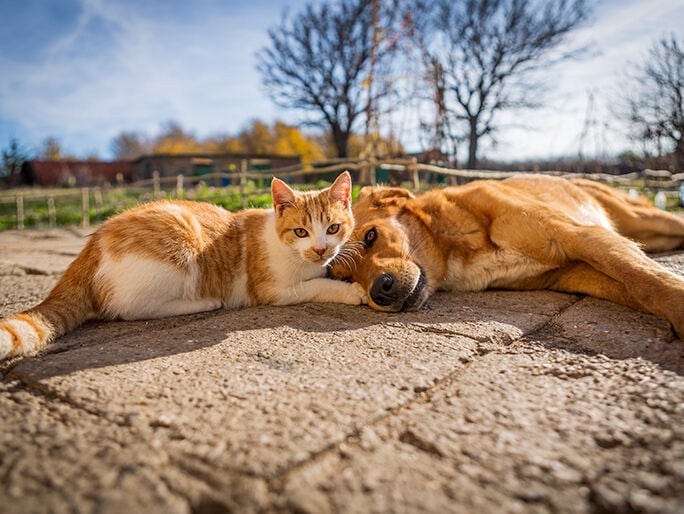healthy food for pets
Simple guidelines for understanding your pet’s dietary needs.
Overwhelmed by all the choices in the pet food aisle? Here are some helpful tips on how to feed your dog or cat.

The building blocks of quality nutrition are:
- Critical carbohydrates
- Protein
- Vitamins and minerals
- Water

Excellent pet food is:
- Formulated to meet your pet’s nutritional needs
- Delicious (to them)
- Easily digested for healthy poops
- Provided in the proper serving size to keep your pet happy — and at a healthy weight
- Designed to manage diagnosed diseases or illnesses
What’s the “best” pet food? One that delivers quality nutrition to support pet health!
All living things (including your pet) need essential nutrients to function, but they can’t make them all on their own. Instead, they need to get them from nutrition-packed ingredients in their food.
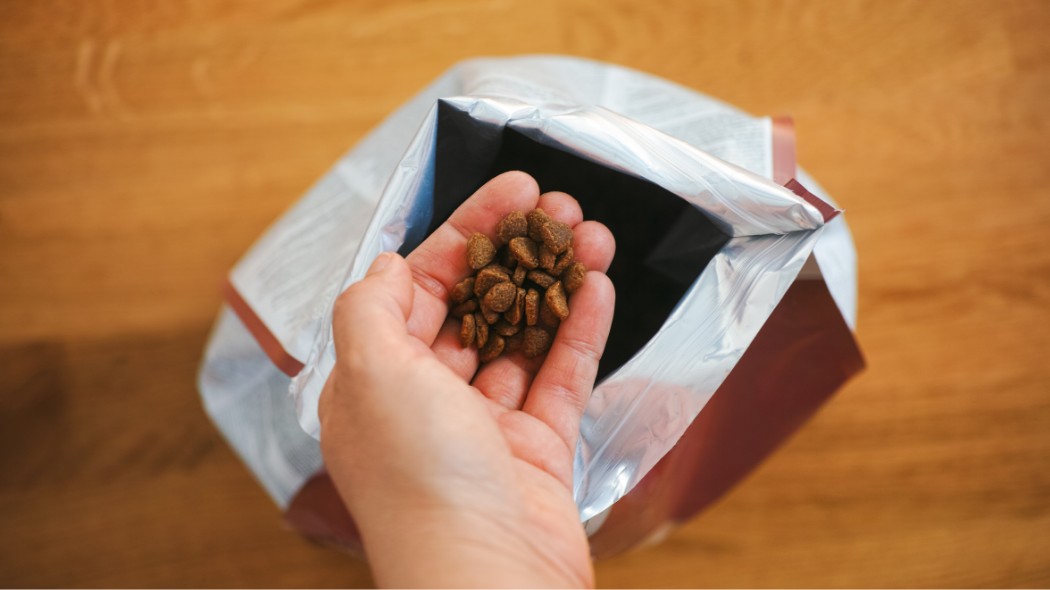
Essential nutrients are the basic building blocks of a quality pet diet
Nutrition is important in any diet because it literally sustains life. Quality pet foods have a scientifically balanced ratio of ingredients that deliver key nutrients like protein, vitamins and minerals, critical carbohydrates, and more.

Critical carbohydrates

Protein

Taurine (for cats)

Vitamins and minerals

Water
How do you pick a quality pet food?
Look for quality pet food that has a scientifically balanced ratio of ingredients that deliver key nutrients like protein, vitamins and minerals, carbohydrates, and more.
Quality cat and dog food comes in many forms
The pet you love needs quality nutrition to support a healthy body — and you can deliver that in many ways. Properly formulated commercial foods deliver the quality nutrition your pet deserves.
- Quality pet foods come in a range of prices, ingredients, flavors, and forms.
- The healthy choice for your pet is a pet food formulated to meet their nutritional needs, that they will happily eat, and that doesn’t cause digestive upset.
- Depending on your pet’s needs, they may benefit from a specifically formulated food designed to support their age, health needs, and dietary preferences.
- Serving sizes can make a difference. Make sure you’re feeding your pet the right formulation and amount for their size, breed, and age.
How to pick a quality commercial pet food
Quality commercial diets can take a lot of the guesswork out of managing pet nutrition. These foods are formulated by veterinary nutritionists, supply serving size suggestions based on your pet’s weight and nutritional needs, and are designed to be both easy to feed and digest.These foods are typically labeled according to species (like cat or dog) and life stage (like puppy or kitten). Industry standards require these foods to show a list of ingredients plus a guaranteed analysis of how much crude protein or fat is in each serving.
Many commercial foods follow standards set by the United States Food and Drug Administration (USFDA) and the Association of American Feed Control Officials (AAFCO). Looking for the USFDA and AAFCO labels is one simple way to ensure the manufacturer is abiding by industry standards for quality and safety.
Some pet owners are concerned about ingredients like animal byproducts, meat, bone meal, and ground whole corn in commercial pet food. However, many of these ingredients are power players for pet nutrition.Get tips on reading pet food labels

Alternative or natural diets are a popular option for pets. The terms natural, holistic, and organic don’t actually mean very much for pet food and do not necessarily indicate a healthy or complete diet for your pets. Speak with your veterinarian before feeding your pet any of these.
Raw and homemade food diets for pets
Although raw food diets sound like a clever idea for animals descended from the wild and homemade diets sound like a wonderful way to show your love for your pet, it is exceedingly difficult to safely feed your pet consistently. We do not recommend raw food or homemade diets unless you have a specific reason to use them as a balanced diet.
Please discuss this choice with your veterinarian or veterinary nutritionist first to ensure raw or homemade food is best for your pet.
Is wet food better than dry food for my pet?
So long as your pet is getting the nutrition they need, it doesn’t matter if you serve wet food, dry food, or a mix of both. What’s best depends on you, your pet, how much space you have for food storage, and your wallet.Dry foods deliver more nutrition in a smaller form, and they will not spoil as quickly in your pet’s bowl. They do have one benefit over wet foods in that some varieties are designed to help reduce dental plaque. It’s worth asking your veterinary team what they recommend.
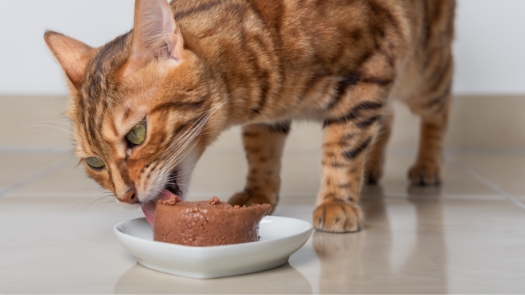
Serving sizes: How much should I be feeding my pet?
Many different variables — like age, lifestyle, health needs, and more — will inform how many calories your pet needs each day. Certain conditions, like diabetes and obesity, will also affect how much and how often your pet needs to be fed.While quality commercial pet foods come with suggested serving sizes on the label, it’s always worth consulting with your veterinary team.
Banfield can help with suggested calorie counts, serving sizes, and a healthy feeding schedule for your unique pet.
What’s the worst diet for pets? Human table scraps!
Many people foods are toxic to pets, even in tiny amounts. Even if your pet’s stomach tolerates the occasional table treat, be aware that people foods are high in calories, fat, salt, sugar, and other —not-so-hot-for-pets ingredients.
Pets don’t need to eat your food to know that you love them. We promise.
Get help switching your pet’s food — without (too much) diarrhea
Transitioning your pet to a new diet? Feeding your pet a new food can often cause digestive upset, which usually translates to distressing pet diarrhea and other problems. Even if you’re switching from one top-quality brand to another, we recommend taking it slow.
- Expect fully switching to new food to take at least a week
- Start with 75% old food at the beginning of the week, move to 50/50 by midweek, then start the all-new diet the first day of the new week.
- Keep an eye on your pet’s poop, which can let you know how happy their stomach is with their new food.
- If your dog is experiencing major upset even after a slow transition, contact your veterinary team for advice.

Worried about your pet? Ping Pet Chat™!
Whether it's 3 a.m. or 3 p.m., connect with a real veterinary professional for immediate petcare advice. It's included in all Optimum Wellness Plans®!
Log in to start chattingHow Banfield can help with dog and cat diet and nutrition
What your pet eats can make a big difference to their health! Our vets can perform physical exams, run tests, and help you manage your pet’s food-related issues, including obesity, diabetes, and food allergies.

Get help managing pet food allergies. Do you think your pet’s immune system is reacting to certain ingredients in their food? We can help identify pet food allergies and work with you on management diets.
Does your pet have diabetes? Let’s work together! This includes everything from recommendations on what to feed your pet, how to manage their food and injection schedule, providing appropriate prescriptions, and showing you how to safely perform insulin injections for the pet you love.
We can help your pet reach a healthy weight. We've got advice on diet and exercise for both overweight and underweight pets. Does your pet have a mobility issue that makes it hard for them to exercise? We can help there, too.
 Mites and mange
Mites and mange Podcast - Not Just Fluff
Podcast - Not Just Fluff

